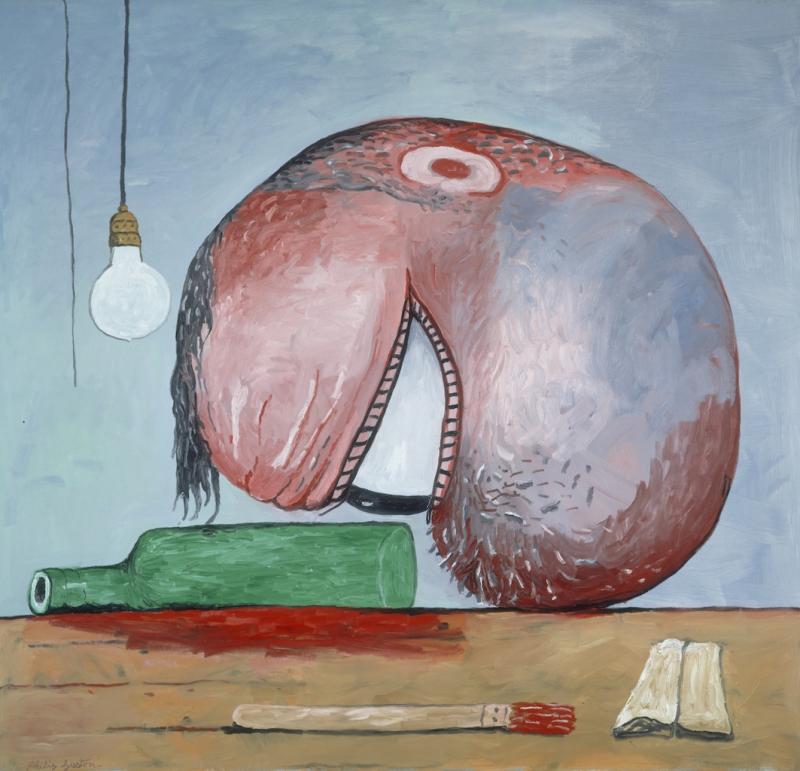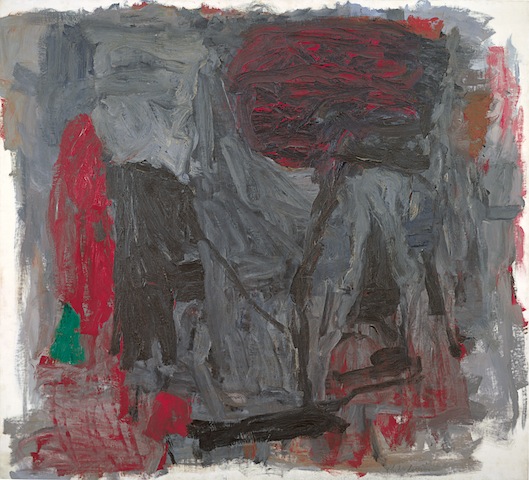Philip Guston, Timothy Taylor Gallery | reviews, news & interviews
Philip Guston, Timothy Taylor Gallery
Philip Guston, Timothy Taylor Gallery
Small but powerful survey of the American artist's late figurative paintings

Light. Light banishes the shadows where monsters lurk and where ghosts rattle their chains. “Give me some light, away!” cries the usurping king in Hamlet as his murderous deed is exposed by the trickery of art. What guilt plagues and seizes his conscience, and yet Claudius, conflicted, cannot pray. He must, therefore, remain a captive among the ghosts and the monsters where no light may fall.
What did light mean for Philip Guston? Not what it means for most painters, nor for those seeking the redemptive light. The naked light bulb that pops up in so many of his paintings is both the interrogator’s tool and the hangman’s noose. These are what that repeated motif reminds us of. And what a world it illuminates for the burdened artist confined to his studio/cell where he too is held captive by ghosts. Those dumb one-eyed potato-heads and hooded Ku Klux Klan figures are both self-portraits of sorts; tragicomic figures in a schematic universe filled with symbolic objects like any Renaissance painting.
Guston made the transition from abstract painter to a kind of cartoon 'allegorical realism'
In Head and Bottle, 1975 (main picture) a bulb, suspended by a looped cable, casts its sickly glow over a green wine bottle lying on its side in a pool of red paint. The artist is “interrogating” his subject, his massive Cyclopian eye almost grazing the bottle’s surface. How to capture the bottle’s essence, he might be wondering, for the bottle is a formal problem to be solved. But we also sense that the artist depends on the bottle to solve other problems too. He is a head, and only a head – albeit a head that partly resembles a bruised testicle – and what are heads for but for solving things, even if the solution to be found is in the act of obliterating thought by taking to the bottle.
Nearby in the painting, we find the artist’s paint-clotted brush, placed neatly in a straight horizontal line, and a book, or perhaps newspaper, placed neatly in a vertical line. The pages are blank. All is reduced to simple geometry expressed through cartoon iconography. These motifs are soft, fleshy, oozey, like the soft sculptures of Claes Oldenburg. The palette too is reduced. Bruised and lurid fleshy pinks predominate in Guston’s late figurative paintings, and this small survey at the Timothy Taylor Gallery presents paintings and drawings from the last two decades of Guston’s life, from 1960 to 1979, the year before he died.
It was at the beginning of this period that Guston made the transition from abstract painter to a kind of cartoon “allegorical realism”, a return of sorts to a mode of painting with which he’d begun his career in the 1930s, when American Regionalism was at its peak, but simplified, grubbier, made banal.
The painting which kicks off this exhibition is the large-scale Traveller III (pictured below; © The Estate of Philip Guston, courtesy Acquavella Galleries), a densely brooding mass of greys ignited by passages of red and a single lozenge of green nestling in a corner (already we see that colour scheme in place; Guston’s early abstracts are also infused with reds and pinks). The dominating shape rising up through this morass of greys could be a tornado. It could be a mushroom cloud. There’s a lot of compressed energy in those brushstrokes, but the painting feels inert. You spot inchoate Klansmen.
 And so we begin with the fag end of Guston’s New York School, Abstract Expressionist period, the fag end of his immersion in the vocabulary of modernism, and the fag end of modernism itself. The rest of the exhibition, consisting of around 26 paintings and drawings of varying sizes, is taken up with works featuring the imagery for which Guston is now known.
And so we begin with the fag end of Guston’s New York School, Abstract Expressionist period, the fag end of his immersion in the vocabulary of modernism, and the fag end of modernism itself. The rest of the exhibition, consisting of around 26 paintings and drawings of varying sizes, is taken up with works featuring the imagery for which Guston is now known.
So what ghosts and inner conflicts plagued him? When he painted the soles of shoes – the stacked piles of shoes that we find in many of his large-scale works, and the single crumpled pair we find here in a smaller study – we imagine the burden of confronting and memorialising the Holocaust as one who was Jewish, and the anti-Semitism and the racism he felt to his bones growing up in Los Angeles in the 1920s. His Klansmen hark back to that period, to the second wave of Ku Klux Klan activity. Born to Ukrainian-Jewish émigré parents the family name was actually Goldstein. We know that when he was 10 or 11 he found his father's body after he'd hanged himself. That light bub isn't just a light bulb.
Light bulbs, Klansmen, shoes, clocks, books, potato-headed artists, dog-ends from cigarettes smoked through the night in creative meditation. There is so much of the poetry of creation and impotence in Guston’s work. Creation and atrophy. The comic and the tragic. Banality and high art. Like Guston’s 1978 painting The Line, which depicts an aged hand descending from a cloud and making a thick mark with a piece of charcoal held between two figures – a riff, of course, on Michelangelo’s hand of God – Head and Bottle denotes the single all-seeing eye of the creator. It looks. We look. Watch out, it will follow you around the room and out the door. Guston’s work gets inside your head.
Explore topics
Share this article
The future of Arts Journalism
You can stop theartsdesk.com closing!
We urgently need financing to survive. Our fundraising drive has thus far raised £33,000 but we need to reach £100,000 or we will be forced to close. Please contribute here: https://gofund.me/c3f6033d
And if you can forward this information to anyone who might assist, we’d be grateful.

Subscribe to theartsdesk.com
Thank you for continuing to read our work on theartsdesk.com. For unlimited access to every article in its entirety, including our archive of more than 15,000 pieces, we're asking for £5 per month or £40 per year. We feel it's a very good deal, and hope you do too.
To take a subscription now simply click here.
And if you're looking for that extra gift for a friend or family member, why not treat them to a theartsdesk.com gift subscription?
more Visual arts
 Help to give theartsdesk a future!
Support our GoFundMe appeal
Help to give theartsdesk a future!
Support our GoFundMe appeal
 Ed Atkins, Tate Britain review - hiding behind computer generated doppelgängers
Emotions too raw to explore
Ed Atkins, Tate Britain review - hiding behind computer generated doppelgängers
Emotions too raw to explore
 Echoes: Stone Circles, Community and Heritage, Stonehenge Visitor Centre review - young photographers explore ancient resonances
The ancient monument opens its first exhibition of new photography
Echoes: Stone Circles, Community and Heritage, Stonehenge Visitor Centre review - young photographers explore ancient resonances
The ancient monument opens its first exhibition of new photography
 Hylozoic/Desires: Salt Cosmologies, Somerset House and The Hedge of Halomancy, Tate Britain review - the power of white powder
A strong message diluted by space and time
Hylozoic/Desires: Salt Cosmologies, Somerset House and The Hedge of Halomancy, Tate Britain review - the power of white powder
A strong message diluted by space and time
 Mickalene Thomas, All About Love, Hayward Gallery review - all that glitters
The shock of the glue: rhinestones to the ready
Mickalene Thomas, All About Love, Hayward Gallery review - all that glitters
The shock of the glue: rhinestones to the ready
 Interview: Polar photographer Sebastian Copeland talks about the dramatic changes in the Arctic
An ominous shift has come with dark patches appearing on the Greenland ice sheet
Interview: Polar photographer Sebastian Copeland talks about the dramatic changes in the Arctic
An ominous shift has come with dark patches appearing on the Greenland ice sheet
 Donald Rodney: Visceral Canker, Whitechapel Gallery review - absence made powerfully present
Illness as a drive to creativity
Donald Rodney: Visceral Canker, Whitechapel Gallery review - absence made powerfully present
Illness as a drive to creativity
 Noah Davis, Barbican review - the ordinary made strangely compelling
A voice from the margins
Noah Davis, Barbican review - the ordinary made strangely compelling
A voice from the margins
 Best of 2024: Visual Arts
A great year for women artists
Best of 2024: Visual Arts
A great year for women artists
 Electric Dreams: Art and Technology Before the Internet, Tate Modern review - an exhaustive and exhausting show
Flashing lights, beeps and buzzes are diverting, but quickly pall
Electric Dreams: Art and Technology Before the Internet, Tate Modern review - an exhaustive and exhausting show
Flashing lights, beeps and buzzes are diverting, but quickly pall
 ARK: United States V by Laurie Anderson, Aviva Studios, Manchester review - a vessel for the thoughts and imaginings of a lifetime
Despite anticipating disaster, this mesmerising voyage is full of hope
ARK: United States V by Laurie Anderson, Aviva Studios, Manchester review - a vessel for the thoughts and imaginings of a lifetime
Despite anticipating disaster, this mesmerising voyage is full of hope

Add comment